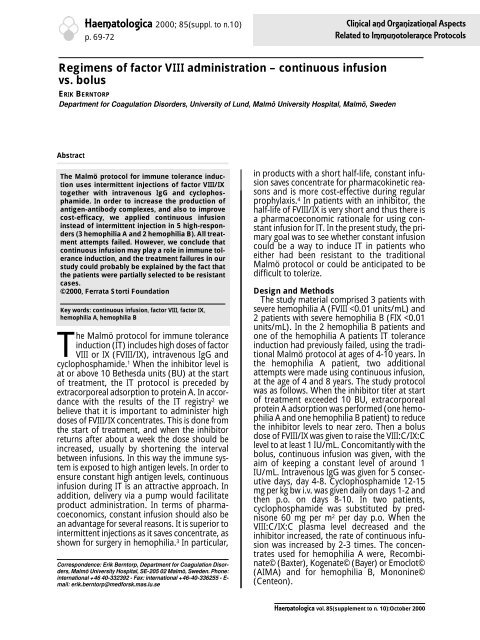Haematologica 2000;85:supplement to no. 10 - Supplements ...
Haematologica 2000;85:supplement to no. 10 - Supplements ...
Haematologica 2000;85:supplement to no. 10 - Supplements ...
You also want an ePaper? Increase the reach of your titles
YUMPU automatically turns print PDFs into web optimized ePapers that Google loves.
<strong>Haema<strong>to</strong>logica</strong> <strong>2000</strong>; <strong>85</strong>(suppl. <strong>to</strong> n.<strong>10</strong>)<br />
p. 69-72<br />
Clinical and Organizational Aspects<br />
Related <strong>to</strong> Immu<strong>no</strong><strong>to</strong>lerance Pro<strong>to</strong>cols<br />
Regimens of fac<strong>to</strong>r VIII administration – continuous infusion<br />
vs. bolus<br />
ERIK BERNTORP<br />
Department for Coagulation Disorders, University of Lund, Malmö University Hospital, Malmö, Sweden<br />
Abstract<br />
The Malmö pro<strong>to</strong>col for immune <strong>to</strong>lerance induction<br />
uses intermittent injections of fac<strong>to</strong>r VIII/IX<br />
<strong>to</strong>gether with intrave<strong>no</strong>us IgG and cyclophosphamide.<br />
In order <strong>to</strong> increase the production of<br />
antigen-antibody complexes, and also <strong>to</strong> improve<br />
cost-efficacy, we applied continuous infusion<br />
instead of intermittent injection in 5 high-responders<br />
(3 hemophilia A and 2 hemophilia B). All treatment<br />
attempts failed. However, we conclude that<br />
continuous infusion may play a role in immune <strong>to</strong>lerance<br />
induction, and the treatment failures in our<br />
study could probably be explained by the fact that<br />
the patients were partially selected <strong>to</strong> be resistant<br />
cases.<br />
©<strong>2000</strong>, Ferrata S<strong>to</strong>rti Foundation<br />
Key words: continuous infusion, fac<strong>to</strong>r VIII, fac<strong>to</strong>r IX,<br />
hemophilia A, hemophilia B<br />
The Malmö pro<strong>to</strong>col for immune <strong>to</strong>lerance<br />
induction (IT) includes high doses of fac<strong>to</strong>r<br />
VIII or IX (FVIII/IX), intrave<strong>no</strong>us IgG and<br />
cyclophosphamide. 1 When the inhibi<strong>to</strong>r level is<br />
at or above <strong>10</strong> Bethesda units (BU) at the start<br />
of treatment, the IT pro<strong>to</strong>col is preceded by<br />
extracorporeal adsorption <strong>to</strong> protein A. In accordance<br />
with the results of the IT registry 2 we<br />
believe that it is important <strong>to</strong> administer high<br />
doses of FVIII/IX concentrates. This is done from<br />
the start of treatment, and when the inhibi<strong>to</strong>r<br />
returns after about a week the dose should be<br />
increased, usually by shortening the interval<br />
between infusions. In this way the immune system<br />
is exposed <strong>to</strong> high antigen levels. In order <strong>to</strong><br />
ensure constant high antigen levels, continuous<br />
infusion during IT is an attractive approach. In<br />
addition, delivery via a pump would facilitate<br />
product administration. In terms of pharmacoeco<strong>no</strong>mics,<br />
constant infusion should also be<br />
an advantage for several reasons. It is superior <strong>to</strong><br />
intermittent injections as it saves concentrate, as<br />
shown for surgery in hemophilia. 3 In particular,<br />
Correspondence: Erik Bern<strong>to</strong>rp, Department for Coagulation Disorders,<br />
Malmö University Hospital, SE-205 02 Malmö, Sweden. Phone:<br />
international +46 40-332392 - Fax: international +46-40-336255 - E-<br />
mail: erik.bern<strong>to</strong>rp@medforsk.mas.lu.se<br />
in products with a short half-life, constant infusion<br />
saves concentrate for pharmacokinetic reasons<br />
and is more cost-effective during regular<br />
prophylaxis. 4 In patients with an inhibi<strong>to</strong>r, the<br />
half-life of FVIII/IX is very short and thus there is<br />
a pharmacoeco<strong>no</strong>mic rationale for using constant<br />
infusion for IT. In the present study, the primary<br />
goal was <strong>to</strong> see whether constant infusion<br />
could be a way <strong>to</strong> induce IT in patients who<br />
either had been resistant <strong>to</strong> the traditional<br />
Malmö pro<strong>to</strong>col or could be anticipated <strong>to</strong> be<br />
difficult <strong>to</strong> <strong>to</strong>lerize.<br />
Design and Methods<br />
The study material comprised 3 patients with<br />
severe hemophilia A (FVIII
















